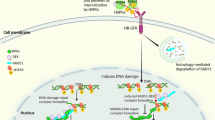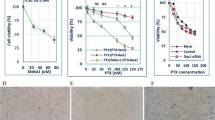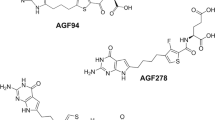Abstract
Ovarian cancer (OC) in which carbonyl reductase 1 (CBR1) is highly expressed has good prognosis. The aims of this study were to determine the optimal conditions for delivering CBR1 DNA to OC cells via a polyamidoamine (PAMAM) dendrimer and to examine the therapeutic effectiveness of using a CBR1/PAMAM dendrimer to treat OC. The ratio for mixture of the PAMAM dendrimer and CBR1 plasmid DNA was defined as the ratio of the number of moles of phosphate groups in plasmid DNA to the number of moles of amino groups in PAMAM, which was expressed as N/P ratio. Mice were intraperitoneally injected with OC cells (HRA) to create peritoneal carcinomatosis. CBR1 DNA/PAMAM dendrimer complexes were administered on alternate days after injection of HRA cells. Cells transfected with CBR1 DNA at N/P ratio of 20:1 for 48 h produced the highest level of CBR1 expression. All the mice in control group died prior to day 25. However, all the mice administered the CBR1 DNA/PAMAM dendrimer survived (P<0.001). Use of a PAMAM dendrimer allowed CBR1 DNA to be delivered to cancer cells. The results suggested that CBR1 DNA/PAMAM dendrimer complexes may represent a potent gene therapy for the treatment of advanced OC.
This is a preview of subscription content, access via your institution
Access options
Subscribe to this journal
Receive 12 print issues and online access
$259.00 per year
only $21.58 per issue
Buy this article
- Purchase on Springer Link
- Instant access to full article PDF
Prices may be subject to local taxes which are calculated during checkout




Similar content being viewed by others

References
Siegel R, Naishadham D, Jemal A . Cancer statistics, 2013. CA Cancer J Clin 2013; 63: 11–30.
Heintz APM, Odicino F, Maisonneuve P, Quinn MA, Benedet JL, Creasman WT et al. Carcinoma of the ovary. Int J Gynaecol Obstet 2006; 95: S161–S192.
McGuire WP, Hoskins WJ, Brady MF, Kucera PR, Partridge EE, Look KY et al. Cyclophosphamide and cisplatin compared with paclitaxel and cisplatin in patients with stage III and stage IV ovarian cancer. N Engl J Med 1996; 334: 1–6.
Yokoyama Y, Futagami M, Watanabe J, Sato N, Terada Y, Miura F et al. Redistribution of resistance and sensitivity to platinum during the observation period following treatment of epithelial ovarian cancer. Mol Clin Oncol 2014; 2: 212–218.
Yokoyama Y, Xin B, Shigeto T, Umemoto M, Kasai-Sakamoto A, Futagami M et al. Clofibric acid, a peroxisome proliferator-activated receptor α ligand, inhibits growth of human ovarian cancer. Mol Cancer Ther 2007; 6: 1379–1386.
Wang H, Yokoyama Y, Tsuchida S, Mizunuma H . Malignant ovarian tumors with induced expression of carbonyl reductase show spontaneous regression. Clin Med Insights Oncol 2012; 6: 107–115.
Osawa Y, Yokoyama Y, Shigeto T, Futagami M, Mizunuma H . Decreased expression of carbonyl reductase 1 promotes ovarian cancer growth and proliferation. Int J Oncol 2015; 46: 1252–1258.
Zhou J, Wu J, Hafdi N, Behr JP, Erbacher P, Peng L . PAMAM dendrimers for efficient siRNA delivery and potent gene silencing. Chem Commun 2006; 22: 2362–2364.
Kukowska-Latallo JF, Bielinska AU, Johnson J, Spindler R, Tomalia DA, Baker JR Jr . Efficient transfer of genetic material into mammalian cells using Starburst polyamidoamine dendrimers. Proc Natl Acad Sci USA 1996; 93: 4897–4902.
Eichman JD, Bielinska AU, Kukowska-Latallo JF, Baker JR Jr . The use of PAMAM dendrimers in the efficient transfer of genetic material into cells. Pharm Sci Technolo Today 2000; 3: 232–245.
Fu HL, Cheng SX, Zhang XZ, Zhuo RX . Dendrimer/DNA complexed encapsulated functional biodegradable polymer for substrate-mediated gene delivery. J Gene Med 2008; 10: 1334–1342.
Kikuchi Y, Kizawa I, Oomori K, Miyauchi M, Kita T, Sugita M et al. Establishment of a human ovarian cancer cell line capable of forming ascites in nude mice and effects of tranexamic acid on cell proliferation and ascites formation. Cancer Res 1987; 47: 592–596.
Mukherjee SP, Byrne HJ . Polyamidoamine dendrimer nanoparticle cytotoxicity, oxidative stress, caspase activation and inflammatory response: experimental observation and numerical simulation. Nanomedicine 2013; 9: 202–211.
Murakami A, Fukushima C, Yoshidomi K, Sueoka K, Nawata S, Yokoyama Y et al. Suppression of carbonyl reductase expression enhances malignant behaviors in uterine cervical squamous cell carcinoma: carbonyl reductase predicts prognosis and lymph node metastasis. Cancer Lett 2011; 311: 77–84.
Murakami A, Yakabe K, Yoshidomi K, Sueoka K, Nawata S, Yokoyama Y et al. Decreased carbonyl reductase 1 promotes malignant behaviors by induction of epithelial mesenchymal transition and its clinical significance. Cancer Lett 2012; 323: 69–76.
Umemoto M, Yokoyama Y, Sato S, Tsuchida S, Al-Mulla F, Saito Y . Carbonyl reductase as a significant predictor of survival and lymph node metastasis in epithelial ovarian cancer. Br J Cancer 2001; 85: 1032–1036.
Ismail E, Al-Mulla F, Tsuchida S, Suto K, Motley P, Harrison PR et al. Carbonyl reductase: a novel metastasis-modulating function. Cancer Res 2000; 60: 1173–1176.
Zhou J, Wu J, Hafdi N, Behr JP, Erbacher P, Peng L . PAMAM dendrimers for efficient si RNA delivery and potent gene silencing. Chem Commum 2006; 10: 2362–2364.
Burger RA, Brady MF, Bookman MA, Fleming GF, Monk BJ, Huang H et al. Incorporation of bevacizumab in the primary treatment of ovarian cancer. N Engl J Med 2011; 365: 2473–2483.
Perren TJ, Swart AM, Pfisterer J, Ledermann JA, Pujade-Lauraine E, Kristensen G et al. A phase 3 trial of bevacizumab in ovarian cancer. N Engl J Med 2011; 365: 2484–2496.
du Bois A, Floquet A, Kim JW, Rau J, del Campo JM, Friedlander M et al. Incorporation of pazopanib in maintenance therapy of ovarian cancer. J Clin Oncol 2014; 32: 3374–3382.
Behbakht K, Sill MW, Darcy KM, Rubin SC, Mannel RS, Waggoner S et al. Phase II trial of the mTOR inhibitor, temsirolimus and evaluation of circulating tumor cells and tumor biomarkers in persistent and recurrent epithelial ovarian and primary peritoneal malignancies: a Gynecologic Oncology Group study. Gynecol Oncol 2011; 123: 19–26.
Monk BL, Poveda A, Vergote I, Raspagliesi F, Fujiwara K, Bae DS et al. Anti-angiopoietin therapy with trebananib for recurrent ovarian cancer (TRINOVA-1): a randomised, multicentre, double-blind, placebo-controlled phase 3 trial. Lancet Oncol 2014; 15: 799–808.
Tsuda N, Mochizuki K, Harada M, Sukehiro A, Kawano K, Yamada A et al. Vaccination with predesignated or evidence-based peptides for patients with recurrent gynecologic cancers. J Immunother 2004; 27: 60–72.
Cross D, Burmester JK . Gene therapy for cancer treatment: pas, present and future. Clin Med Res 2006; 4: 218–227.
Yoo GH, Moon J, Leblanc M, Lonardo F, Urba S, Kim H et al. A phase 2 trial of surgery with perioperative INGN 201 (Ad5CMV-p53) gene therapy followed by chemoradiotherapy for advanced, resectable squamous cell carcinoma of the oral cavity, oropharynx, hypopharynx, and larynx: report of the Southwest Oncology Group. Arch Otolaryngol Head Neck Surg 2009; 135: 869–874.
Pagliaro LC, Keyhani A, Williams D, Woods D, Liu B, Perrotte P et al. Repeated intravesical instillations of an adenoviral vector in patients with locally advanced bladder cancer: a phase I study of p53 gene therapy. J Clin Oncol 2003; 21: 2247–2253.
Vasey PA, Shulman LN, Campos S, Davis J, Gore M, Johnston S et al. Phase I trial of intraperitoneal injection of the E1B-55-kd-gene-deleted adenovirus ONYX-015 (dl1520) given on days 1 through 5 every 3 weeks in patients with recurrent/refractory epithelial ovarian cancer. J Clin Oncol 2002; 20: 1562–1569.
Lang FF, Bruner JM, Fuller GN, Aldape K, Prados MD, Chang S et al. Phase I trial of adenovirus-mediated p53 gene therapy for recurrent glioma: biological and clinical results. J Clin Oncol 2003; 21: 2508–2518.
Fischer D, Li Y, Ahlemeyer B, Krieglstein J, Kissel T . In vitro cytotoxicity tenting of polycations: influence of polymer structure on cell viability and hemolysis. Biomaterials 2003; 24: 1121–1131.
Bielinska A, Kukowska-Latallo JF, Johnson J, Tomalia DA, Barker JR Jr . Regulation of in vitro gene expression using antisense oligonucleotides or antisense expression plasmids transfected using starburst PAMAM dendrimers. Nucleic Acids Res 1996; 24: 2176–2182.
Ruponen M, Ylä-Herttuala S, Urtti A . Interaction of polymeric and liposomal gene delivery systems with extracellular glycosaminoglycans: physicochemical and transfection studies. Biochim Bilophys Acta 1999; 1415: 331–341.
Acknowledgements
This study was supported by a Grant-in-Aid for Cancer Research from the Ministry of Education, Culture, Sports, Science and Technology (Tokyo, Japan) (no. 20591935 to Dr Y Yokoyama).
Author information
Authors and Affiliations
Corresponding author
Ethics declarations
Competing interests
The authors declare no conflict of interest.
Rights and permissions
About this article
Cite this article
Kobayashi, A., Yokoyama, Y., Osawa, Y. et al. Gene therapy for ovarian cancer using carbonyl reductase 1 DNA with a polyamidoamine dendrimer in mouse models. Cancer Gene Ther 23, 24–28 (2016). https://doi.org/10.1038/cgt.2015.61
Received:
Revised:
Accepted:
Published:
Issue Date:
DOI: https://doi.org/10.1038/cgt.2015.61
This article is cited by
-
Current Update on Nanotechnology-Based Approaches in Ovarian Cancer Therapy
Reproductive Sciences (2023)
-
Development of transgenic mice overexpressing mouse carbonyl reductase 1
Molecular Biology Reports (2023)
-
Inhibitory effect of carbonyl reductase 1 against peritoneal progression of ovarian cancer: evaluation by ex vivo 3D-human peritoneal model
Molecular Biology Reports (2019)
-
A magnetic multifunctional dendrimeric coating on a steel fiber for solid phase microextraction of chlorophenols
Microchimica Acta (2017)
-
A hyperbranched polyamidoamine dendrimer grafted onto magnetized graphene oxide as a sorbent for the extraction of synthetic dyes from foodstuff
Microchimica Acta (2017)


